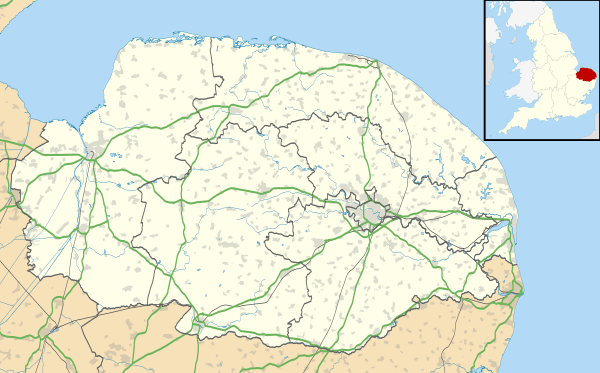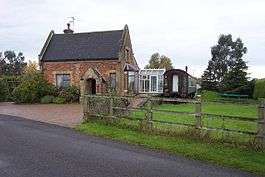Emneth
Emneth is a village and a civil parish in the English county of Norfolk.[1] The village is 58 miles (93 km) west of Norwich, 15.4 miles (24.8 km) south-west of King's Lynn and 99.6 miles (160.3 km) north of London. The nearest town is Wisbech which is 3.3 miles (5.3 km) north-north-west of the village. The Village lies to the south-west of the route of the A47[2] between Peterborough and King's Lynn. The nearest railway station is at Downham Market for the Fen Line which runs between King's Lynn and Cambridge. The nearest airport is Cambridge International Airport. The parish of Emneth in the 2001 census, has a population of 2,466, increasing to 2,617 at the 2011 Census.[3] For the purposes of local government, the parish falls within the district of King's Lynn and West Norfolk.
| Emneth Primary | |
|---|---|
 Parish church of Saint Edmund, Emneth, Norfolk | |
 Emneth Primary Location within Norfolk | |
| Population | 2,617 (parish, 2011 census) |
| OS grid reference | TF5103 |
| • London | 99.6 miles (160.3 km) |
| Civil parish |
|
| District | |
| Shire county | |
| Region | |
| Country | England |
| Sovereign state | United Kingdom |
| Post town | WISBECH |
| Postcode district | PE14 |
| Dialling code | 01945 |
| Police | Norfolk |
| Fire | Norfolk |
| Ambulance | East of England |
| UK Parliament | |
Governance
Emneth parish council has 12 members. The councillors elect a chair. Emneth is part of the electoral ward called Emneth with Outwell. The population of this ward taken at the 2011 Census was 4,700.[4]
Description
This fenland village and parish is on the border with the county of Cambridgeshire in the south west of Norfolk. The village is located south of Walsoken and north of Outwell. Within the parish boundaries of Emneth there are also the settlements of Emneth Hungate and Holly End. Over the years the meaning of the name Emneth[5] has been debated. It is derived from old English and therefore probably has Saxon origins, and may have the meanings of smooth meadow, junction of streams on the River Aemenan, river confluence belonging to Eana or mowing grass meadow. The Hungate suffix suggests this area may have been associated with the keeping or rearing of hounds. The village is not mentioned in the Domesday Book. This may well be because the village was valued with another parish and not named. There is evidence for activity in the parish from the Roman period and metal detectorists have found many medieval and post medieval finds.
History
The earliest mention of Emneth is in documents dating back to 1170 giving proof that a village was settled in the parish by this date. The parish church of Saint Edmund's was built in the 12th century[6] and extended dramatically in the 13th century.[6] It remains a large and imposing building. Other buildings from the medieval period which stood in the parish have been demolished. Hagbeach Hall a medieval hall was demolished in 1887, although its 17th-century stables remain and has been converted into a house. The medieval hall on the site of 17th-century Oxburgh Hall[6] was also demolished when the new hall was built. Other buildings have disappeared. Emneth was also recorded in a document in 1389 but this document's location has since been lost. Other sites have lost their names and sense of importance. A medieval moated site has been recorded and a seal used by Pope Innocent III to secure documents was found there along with other finds which included a medieval seals matrices, a horse harness pendant and medieval coins. Within the parish other more domestic sites with less status have also been identified. Medieval hearths were excavated along with many medieval finds including pottery, coins and personal objects. These include a spectacular strap end with the initials S and J. The number of items recovered at this site suggests that this was an area of substantial medieval settlement.
Landmarks
Saint Edmund Parish Church
This parish church built of stone sits on the bend of the main road. The tower, porch, and nave with its aisles and clerestory are all built in the perpendicular style.[7] There is a sanctus bellcote which has six bells,[8] on the east gable of the nave. Crowning the nave, with its arcades of six bays is a 15th-century roof. Angels adorn its tiebeams and hammerbeams, and figures of the apostles with others carved in the wall posts. The chancel screen dates from the 15th century[7] and has the remains of old painting and gilding and in the north aisle windows in glass as old as the screen are of more angels. The chancel is 13th century[7] and the east window is a fine trinity of lancets reaching up to the roof. The rood-stairs are in a turret by the chancel arch, and there is a simple 15th-century[7] font. The oldest memorials are coffin-lids, one with a border and a cross of leaves. Only the matrix is left of the 11-foot-long (3.4 m) brass of a cross-legged knight dressed in chain mail of about 1300.[7] Sir Thomas Hewar, who died in 1631,[7] planned for himself the fine alabaster tomb on which he lies in gold and white armour and a ruff, with his wife in a black gown and ruff. He had paid Nicholas Stone a London Mason the huge sum of £95[7] for the tomb in 1617. At their feet lies a sleeping child.
War Memorial
Emneth war memorial is located in the graveyard opposite the parish church.
Emneth railway station
Emneth had a railway station which served the village, situated in Station Road and accessed from the village via Ladys Drove. The station was opened in 1848 as an extension of the East Anglian Railway's line from Magdalen Road station (now known as Watlington) to Wisbech East. The station's location, like that of the neighbouring Middle Drove station, was fairly rural and the line eventually closed in 1968, a casualty of the Beeching Axe.[9] In October 1942, a hoard of Roman silver coins together with fragments of an urn in which they were stored was found near the station.[10] Emneth's station building survived closure, and has since been converted into a private residence.
Notable people
- Sir Thomas Howard is buried in Emneth.
- The Reverend Wilbert Awdry (1911-1997) OBE, the author of The Railway Series books, and creator of Thomas the Tank Engine, was Vicar of Emneth between 1953 and 1965. Many of his books were written in the old vicarage in Emneth.
- Tony Martin, a farmer convicted of murder in 1999 after shooting a 16-year-old burglar, Fred Barras, at his farmhouse in Emneth Hungate.
Gallery
 The old station house, now a private house
The old station house, now a private house Tomb Chest of Sir Thomas Hewar, by Nicholas Stone
Tomb Chest of Sir Thomas Hewar, by Nicholas Stone
References
- Ordnance Survey (2006). OS Explorer Map 228 – March & Ely. ISBN 0-319-23802-4
- County A to Z Atlas, Street & Road maps Norfolk, page 230 ISBN 978-1-84348-614-5
- "Parish population 2011". Retrieved 27 August 2015.
- "Emneth with Outwell Ward population 2011". Retrieved 27 August 2015.
- A Popular Guide to Norfolk Place-names: by James Rye: Published by Larks press, Dereham, Norfolk, 2000 ; ISBN 0-948400-15-3
- Norfolk 2: Norfolk: North-west and South, By Nikolaus Pevsner and Bill Wilson, Emneth entry. 0-300-09657-7
- The King's England series, NORFOLK, by Arthur Mee,Pub:Hodder and Stoughton,1972, page 87 Emneth, ISBN 0-340-15061-0
- church bells
- Oppitz, Leslie (1999). Lost Railways of East Anglia (Lost Railways). Newbury, Berkshire: Countryside Books. p. 19. ISBN 1-85306-595-1.
- Wright (1946). "Roman Britain in 1945: I. Sites Explored: II. Inscriptions". The Journal of Roman Studies. 36, Parts 1 and 2: 133–148. JSTOR 298046.
External links
![]()